Now that most Poser users are migrating or have migrated to Poser Pro 11.2, many from Standard or earlier versions of Poser… what super new Pro features do they have access to?
Background on this: Pro is now the only version of Poser. Users of Poser 2014 Game Dev edition, Poser 11 Standard and Poser Pro 11 were all recently updated to Poser Pro 11.2 for free. A $99 upgrade to Pro is on offer for users of earlier versions of Poser, all the way down to the humble Poser Debut or the ancient Poser 6.
Here’s a quick list of what’s in Pro, that may be new to many users of Poser:
* Render to layered Photoshop .PSD file. This is found tucked away on the Render Panel under Firefly | Options | Auxiliary Render Options. This cannot be combined with other render types (e.g. Sketch, Comic Book Preview). In Photoshop you will need to “Paste in place…” these other renders into your scene’s .PSD file. And then name them strictly and consistently in the Layers stack, in order to have automated Actions work with them.
* Render a Toon ID pass, aka ‘Clown Pass’, via the layered Photoshop .PSD file output (see above). Such a pass then enables easy masking and replacing of sky and sea, building facades, etc. (Note: this pass often requires a quick ‘Auto Contrast’, and then a Brightness/Contrast tweak, to make it visible and its parts select-able in Photoshop. There’s a free script which is useful here).
* Render a Z-depth pass, for use in Photoshop (see above). Easily add an atmospheric “depth haze” to a scene.
* FBX and Collada export / import. A single texture map (‘texture atlas’), output alongside the FBX.
* HDRI import/export.
* Queue rendering and network Queue rendering, for stacking renders so they automatically render one after the other. Rendering is done by a separate programme in the background. On many new 64-bit multi-core Windows systems this should make rendering faster, and Poser far more responsive while rendering. From the Poser 11 SR3 patch onward, Queue Manager worked with both SuperFly and Firefly. SR3 also enabled network rendering for Firefly rendering, enabling rendering on a network.
* Background rendering for Firefly and SuperFly. Very usefully renders into its own 64-bit Windows process, thus enabling you to continue working in Poser or other software.
* SuperFly GPU rendering, via a graphics card. SuperFly volumetric effects when GPU rendering (of “limited quality”, when last heard of in the official changelog). Lots of card memory is said to be needed, and the graphics card must be CUDA-based.
* Support for Kinect 1 and 2 for Windows. Used for home motion-capture of poses and animations, though apparently it’s very poor at capturing facial animations even up close. The Microsoft kit is apparently defunct now, but can still be had via eBay etc.
* In-scene measurement tools. Useful for forensic recreations, medical uses, real-world garden planning, architecture etc.
* Text Props used to be a Pro-only feature. Can apply basic text labels, useful for diagrams and infographics. But cannot extrude the flat letter shapes to full 3D.
* Create Control Props (‘Body Handles’), of the type seen on the new flagship La Femme character.
* Fitting Room for clothing.
* Copy morphs between figures, custom morph-injections.
* Suite of weight-map creation tools, and other features useful for clothing and character creators.
* “Smart Polygon reduction”. Far better known as ‘decimation’ or ‘decimate’. Reduce the size of your 3D mesh by automatically removing (‘decimating’) polygons from it, without mangling its surfaces and lines too much.
GoZ, the Poser-ZBrush bridge utility, appears to have been a feature in both Standard and Pro.
The Pro-only PoserFusion plugins were not apparently part of the package sold to Renderosity/Bondware along with Poser 11. However, if you already have these installed, the Cinema 4D one is known to still work happily with Poser 11.2 and C4D up to R19.

